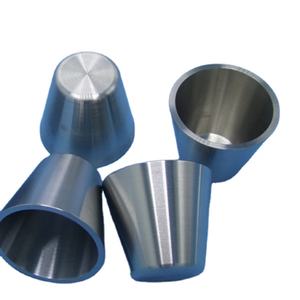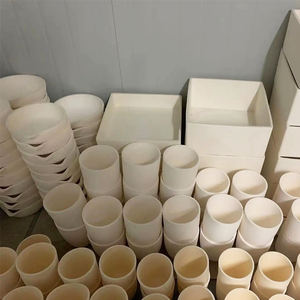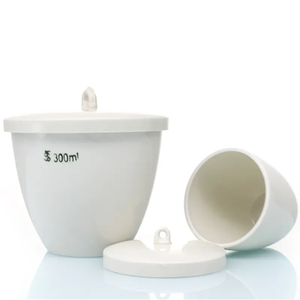Professional industry ceramic supplier, silicon nitride, silicon carbide, aluminum nitride and any other kinds of ceramics.
PRODUCT PARAMETERS
Description
Overview of Lab Analysis Refractory Materials MgO Magnesium Oxide Ceramic Melting Crucible 99% Magnesia Ceramic Crucible
Lab Analysis Refractory Materials MgO Magnesium Oxide Ceramic Melting Crucible 99% Magnesia Ceramic Crucible are specialized containers designed for withstanding extremely high temperatures in laboratory and industrial settings. They are essential for processes such as melting, calcining, and heat-treating a wide variety of materials, including metals, glasses, and chemicals. Our crucibles are engineered for superior thermal stability and chemical resistance, ensuring purity and reliability in the most demanding applications.
Features of Lab Analysis Refractory Materials MgO Magnesium Oxide Ceramic Melting Crucible 99% Magnesia Ceramic Crucible
-
Exceptional Thermal Shock Resistance: Withstands rapid temperature changes without cracking, ensuring durability and a long service life.
-
High-Temperature Stability: Maintains structural integrity at extreme temperatures, often exceeding 1500°C.
-
Excellent Chemical Inertness: Resists corrosion and reaction with molten metals, acids, and aggressive chemical fluxes.
-
High Purity & Low Contamination: Manufactured from premium materials to prevent sample contamination during sensitive processes.
-
Optimized Thermal Properties: Designed for efficient heat transfer and consistent performance in furnace environments.
-
Robust Mechanical Strength: Offers good resistance to physical impact and abrasion during handling and use.
Specifications of Lab Analysis Refractory Materials MgO Magnesium Oxide Ceramic Melting Crucible 99% Magnesia Ceramic Crucible
This crucible is made from magnesium oxide ceramic. MgO purity is high, at least 99%. That makes it a top choice for demanding lab work. It handles very high temperatures well. You can use it reliably up to 2200°C. It also resists thermal shock effectively. This means it won’t crack easily during fast heating or cooling changes. The material is chemically inert too. It doesn’t react easily with most molten metals or slags. This inertness is vital for clean, uncontaminated melts. It’s especially good for precious metals like platinum or gold. It also works well for nickel-based superalloys and rare earth elements. The crucible offers excellent resistance to basic slags. Basic slags are common in many refining processes. This resistance helps the crucible last longer. It keeps its shape under intense heat. You get consistent performance over many uses. The dense structure minimizes porosity. Less porosity means less chance for metal to seep in. This prevents contamination and sticking. The crucible surface stays smooth. That makes pouring molten metal easier and cleaner. It promotes long service life. You save money by needing fewer replacements. It’s a durable and cost-effective tool for high-temperature applications. The design focuses on reliable performance under tough conditions.
Applications of Lab Analysis Refractory Materials MgO Magnesium Oxide Ceramic Melting Crucible 99% Magnesia Ceramic Crucible
This crucible is made from 99% pure magnesium oxide ceramic. People use it for melting stuff in labs. It works great with very hot temperatures. It handles over 1800°C easily. That makes it perfect for checking out refractory materials. These are materials that need to resist extreme heat. Scientists melt samples inside it. They study how the materials behave when molten. They look at reactions and stability. The crucible itself is super stable. It doesn’t react with most molten metals or slags. This keeps the sample pure for good analysis. The high purity magnesia is key. Impurities can mess up test results. So 99% MgO gives reliable data. It lasts longer than cheaper crucibles too. It resists cracking from heat changes. This saves money over time. Lab techs like its strength. It doesn’t break easily during handling. Cleaning it is straightforward after use. It works well in different lab furnaces. It supports accurate high-temperature research.
Company Profile
Tanki New Materials Co.Ltd. focus on the research and development, production and sales of ceramic products, serving the electronics, ceramics, chemical and other industries. Since its establishment in 2015, the company has been committed to providing customers with the best products and services, and has become a leader in the industry through continuous technological innovation and strict quality management.
Our products includes but not limited to Aerogel, Aluminum Nitride, Aluminum Oxide, Boron Carbide, Boron Nitride, Ceramic Crucible, Ceramic Fiber, Quartz Product, Refractory Material, Silicon Carbide, Silicon Nitride, ect. please feel free to contact us.

Payment Methods
T/T, Western Union, Paypal, Credit Card etc.
Shipment Methods
By air, by sea, by express, as customers request.
5 FAQs of Lab Analysis Refractory Materials MgO Magnesium Oxide Ceramic Melting Crucible 99% Magnesia Ceramic Crucible
What is the maximum temperature this crucible can handle?
This crucible works reliably up to 1800°C. It can handle short bursts up to 1850°C. Going hotter risks damage. Always stay below the max for best results. Check your specific lab process needs.
What chemicals does it resist well?
It handles strong alkalis very well. It also resists basic slags effectively. Acid resistance is limited. Avoid strong acids like sulfuric acid. It performs poorly with acidic materials. Know your sample chemistry before use.
How long does the crucible last?
Crucible life depends heavily on use. Constant high heat reduces lifespan. Frequent thermal cycling wears it down faster. Aggressive chemical samples shorten use time. Expect fewer cycles under tough conditions. Handle it carefully to maximize life.
Any special handling needed?
Store the crucible dry. Avoid any moisture exposure. Heat it up slowly to prevent cracking. Don’t cool it down too fast either. Rough handling can cause chips or breaks. Treat it gently to avoid damage.
Why is 99% purity important?
High purity means less unwanted material. Impurities can weaken the crucible. Impurities also contaminate your samples. The 99% MgO offers better corrosion resistance. This purity provides stable results for analysis, like glass testing.
REQUEST A QUOTE
RELATED PRODUCTS

95% Alumina Ceramic Crucible Alumina Thermal Analysis Small Crucible With Lid

Lab Melting Used Fused Silica Quartz Sio2 Ceramic Crucible

Industrial Ceramic Crucible for Metal Melting and Casting

95% Alumina Ceramic Crucible Alumina Thermal Analysis Small Crucible with Lid

High Purity Alumina Ceramic Square Boat Box Sagger and Crucible with Lid Refractory Product



